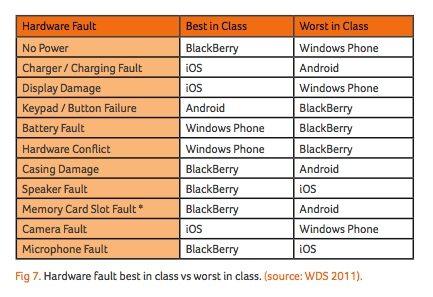Higher volume of device returns theoretically costing $2 billion a year
All Android devices are not created equal and mobile operators need to be aware that certain devices may cost them in the long run, especially if they are mismatched at the point of sale to the customer.
That is the message from customer care and device support specialist, WDS, after it analysed 600,000 calls received to its customer care teams over the past year. WDS found that Android devices suffered a higher level of faults, or perceived faults, due to hardware quality than devices based on other smartphone OS.
WDS found that 14% of technical support calls on Android relate to hardware, versus 11% for Windows Phone, 7% for iOS and 6% for BlackBerry OS.
Tim Deluca-Smith, Vice President of Marketing at WDS, said that because there is a much wider variety of manufacturers developing on Android, there is therefore a wider disparity in the types and quality of hardware being used. Although it offers flexibility to operators, the lack of centralised control over components is also driving cost into their businesses, Deluca-Smith said.
 WDS’ findings about Android returns are released in the same week as Kantar WorldPanel numbers showing that Android now holds a 49.9% share of the UK market, and is now “clearly” the number one OS across Europe.
WDS’ findings about Android returns are released in the same week as Kantar WorldPanel numbers showing that Android now holds a 49.9% share of the UK market, and is now “clearly” the number one OS across Europe.
Smartphones also accounted for 69.1% of all UK handset sales in the UK in the past quarter, so the costs of supporting smartphone devices are now more relevant than ever.
“There’s a naivety that Android is Android,” he said, “but operators need to be aware of the fragmentation issue and be aware of how that impacts the customer experience. You might get a new Android phone with a year old version of the OS, and no capability to upgrade because of hardware constraints.
“Operators need to consider the total lifecycle cost of devices, and that means carrying out more testing of devices, as well as making sure they are matching consumers to the right types of devices.”
That means that operators must be aware that when sales staff sell devices they are correctly matching them to the usage profile of the customer. A low-end phone in the wrong hands will under perform, for instance by not rendering graphics adequately, and may be returned as faulty as a result.
Each return, Deluca-Smith said, costs an operator on average $100 to handle (not including the cost or a replacement phone). With 5-10% of Android phones being returned, WDS came up with a $2 billion cost to operators globally, just in terms of supporting returned Android devices.
Interestingly, Deluca-Smith said that certain manufacturers tend to display certain faults. Apple devices tend to trend high in faulty mics and speakers. Blackberry has problems with button performance, while some manufacturers are more predisposed to touch screen faults.
As items such as screens, mics and buttons are commoditised across device ranges, a high end phone from one OEM may display the same fault in hardware as a low end phone – so it’s not just the case that cheap phones fail more often.
 Additionally, a good feature phone may be preferable to a poorly performing smartphone.
Additionally, a good feature phone may be preferable to a poorly performing smartphone.
“Operators are beginning to say that they wish they had more feature phones still to sell,” Deluca-Smith said.
You can access a download of the full WDS report, Controlling the Android, here: http://www.wds.co/enlightened/whitepaper.asp


